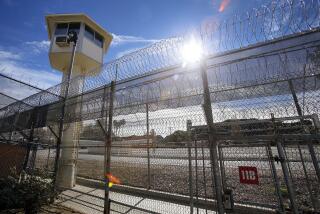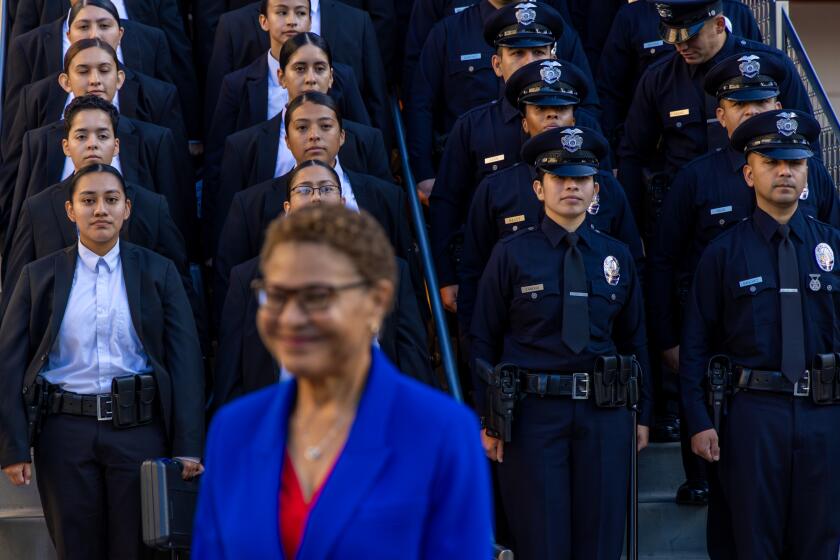Weary Firefighters Find Home Is Out in Left Field
- Share via
FILLMORE — When firefighters started pouring into this tiny town, state and local officials had more to worry about than stopping the Grand fire: namely rounding up enough portable toilets, sleeping bags and food for the weary men and women soon to return from the fire’s front lines.
What was once left field at Fillmore’s only park quickly became home to more than 1,000 firefighters who are eating, sleeping and showering in the 8.5-acre park until the blaze is extinguished. That could take all week even though the number of firefighters, which peaked at 2,000 Monday, is already diminishing.
“In the morning, kids were playing baseball,” said Capt. Michael Mattia of the California Department of Forestry. “In the afternoon, it was a city.”
The “city” in Shiells Park sprang up Sunday almost as quickly as the fire spread.
A caterer from Redding--toting, among other items, 2,640 cartons of milk, 1,800 eggs and 300 tomatoes--had transformed the parking lot and part of a grassy field into a mess hall and served up a hot dinner Monday night.
More than 50 portable toilets were in place on the perimeter of the playground, and drinking water flowed from a 3,500-gallon tanker in the parking lot.
Nearby stood a stand of sinks, complete with complimentary soap and mirrors. Thousands of sleeping bags and double AA radio batteries were distributed at the city “store.” Multicolored tents, where firefighters sleep in shifts, spread throughout the park. “We’ve developed a system to take care of all their needs,” Mattia said.
Well, all but one. Back from battling the blaze Tuesday, scores of men and women wanted a hot shower. But the showers, they were told, had still not arrived.
Instead, they washed their hands and faces at the makeshift stand of sinks before sitting down to a breakfast of eggs, sausage and fresh fruit.
“We worked most of the night, but at 3 a.m. it quieted down. We are tired and hungry. This will be the first hot meal for us since breakfast yesterday,” said James Crabtree, strike team leader for the forestry department.
“Some of the fire was pretty well out, but we still had some work to do,” said Craig Waag, a state fire captain, waiting in line for breakfast early Tuesday. “We’ve been up 27 hours. It’s time to go to sleep, but the first order of business is breakfast.”
(BEGIN TEXT OF INFOBOX / INFOGRAPHIC)
Tips to Protect Your Home
Residents living in wildfire areas can protect themselves--and avoid fines--by clearing hazardous brush and vegetation from their property. Notices were recently mailed to 20,000 residents reminding them how to comply with county fire ordinances by June 1 by clearing away brush, wild grass, dead tree limbs and anything else that can easily catch fire within 100 feet of homes.
Especially vulnerable are houses near chaparral.
The best way to slow a fire is to deprive it of fuel. Individuals can increase the odds that a home will be left standing when the smoke clears by creating a defensible space around it.
Here are a few rules that can help protect you and your home:
* Cut tall grasses and weeds down to stubble within 100 feet of your house. Also remove stacks of lumber or any other combustible litter.
* Prune away all dead vegetation from trees and shrubs. Areas closest to the house, such as under the eaves, are the most critical.
* Remove any limbs that overhang buildings or are within 10 feet of a chimney.
* Keep a buffer of healthy, well-watered, well-maintained, drought-resistant plants around your house.
* Walk around your house and imagine what would happen if the sky were raining sparks--because that’s what happens in a firestorm. Imagine those sparks dropping from the sky and ask yourself what they would ignite first. That’s what you want to get rid of.
More to Read
Sign up for Essential California
The most important California stories and recommendations in your inbox every morning.
You may occasionally receive promotional content from the Los Angeles Times.










